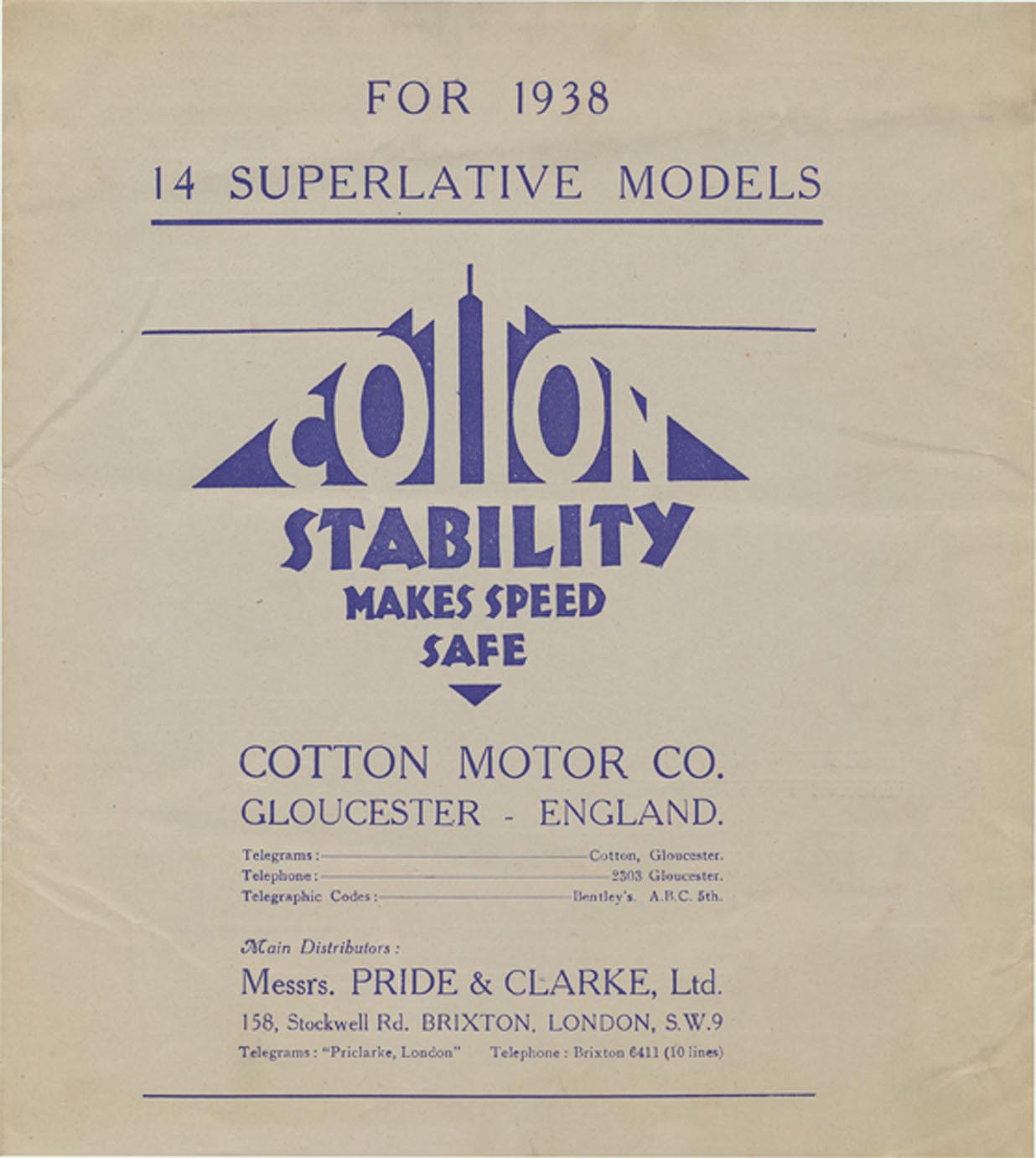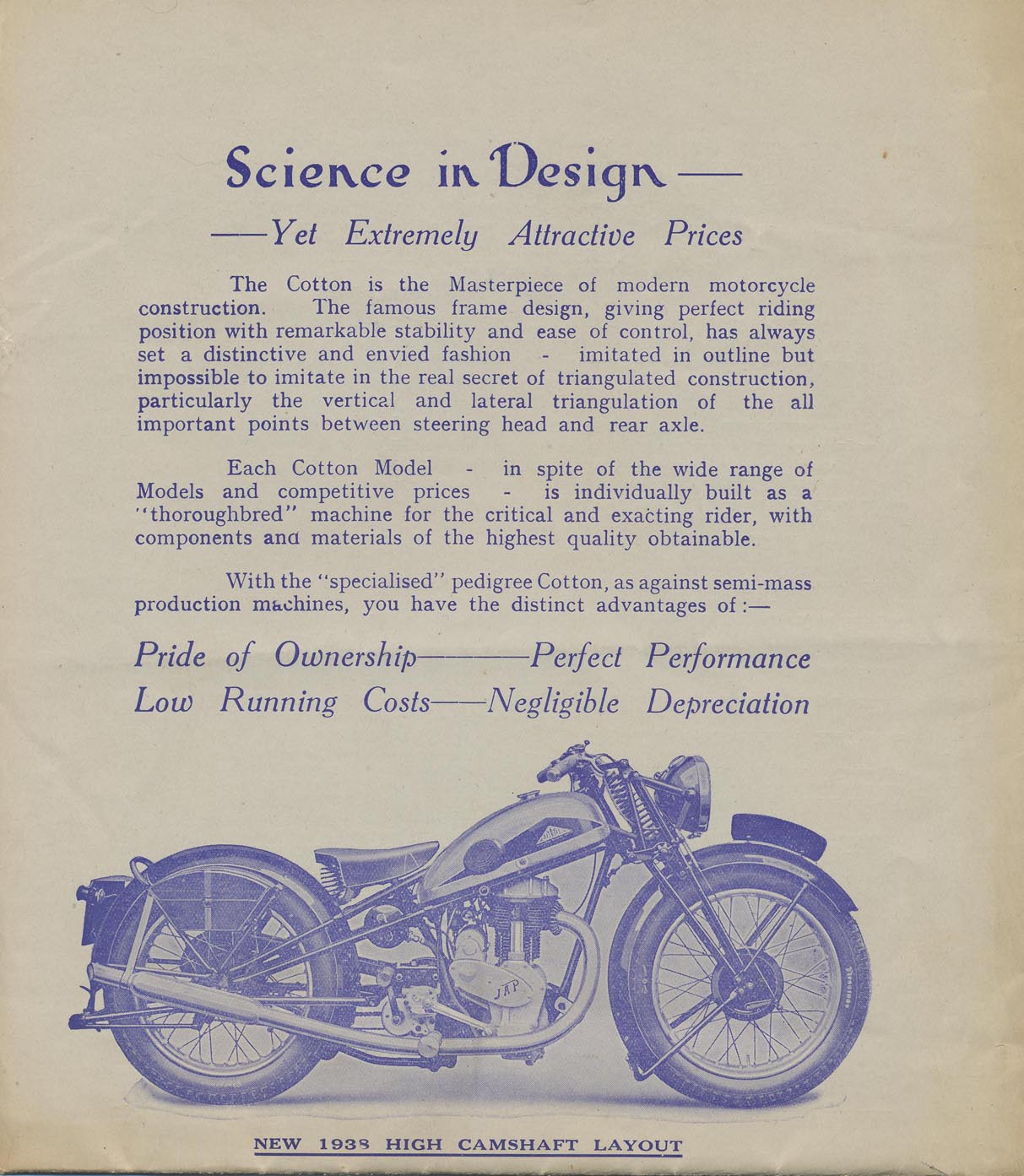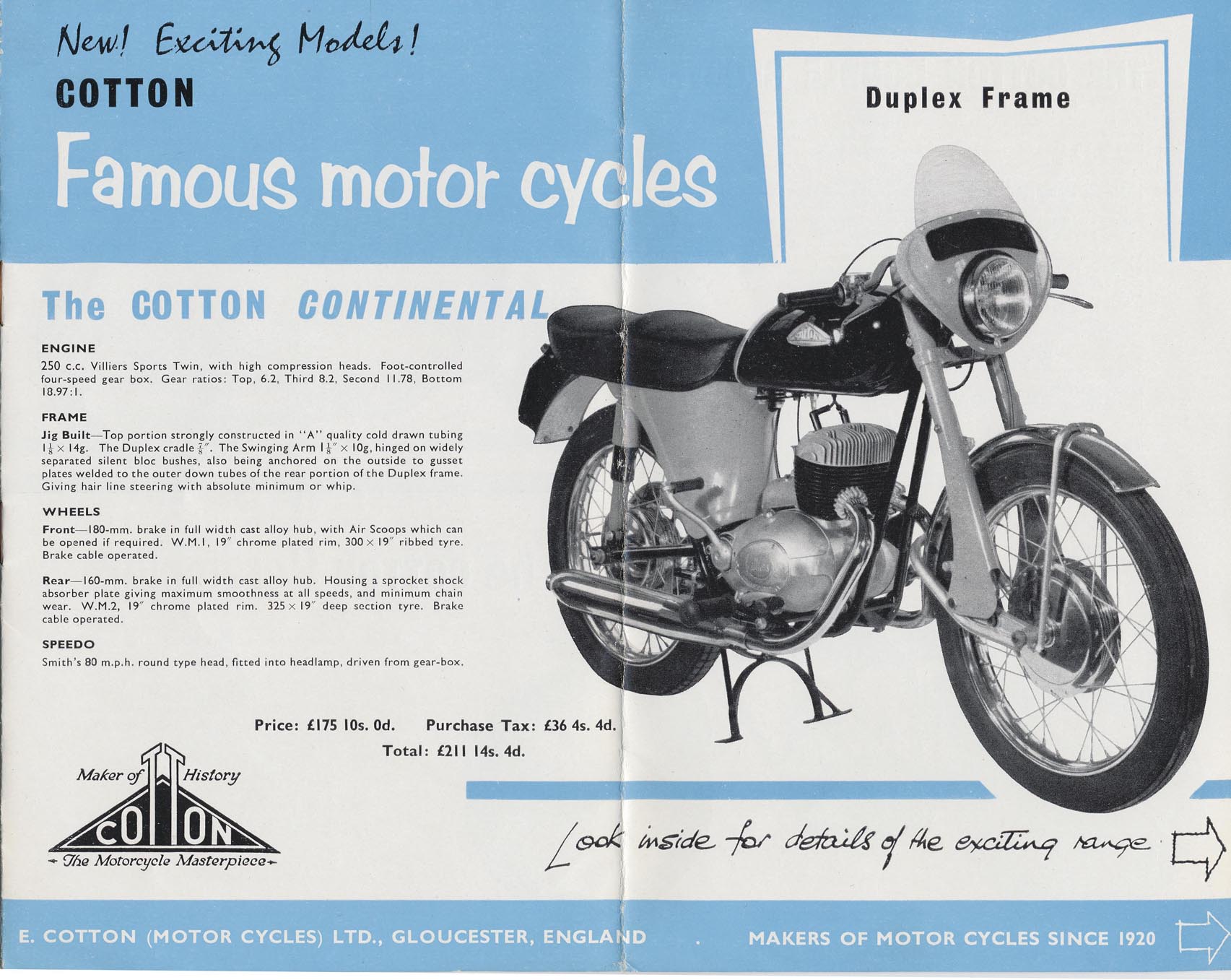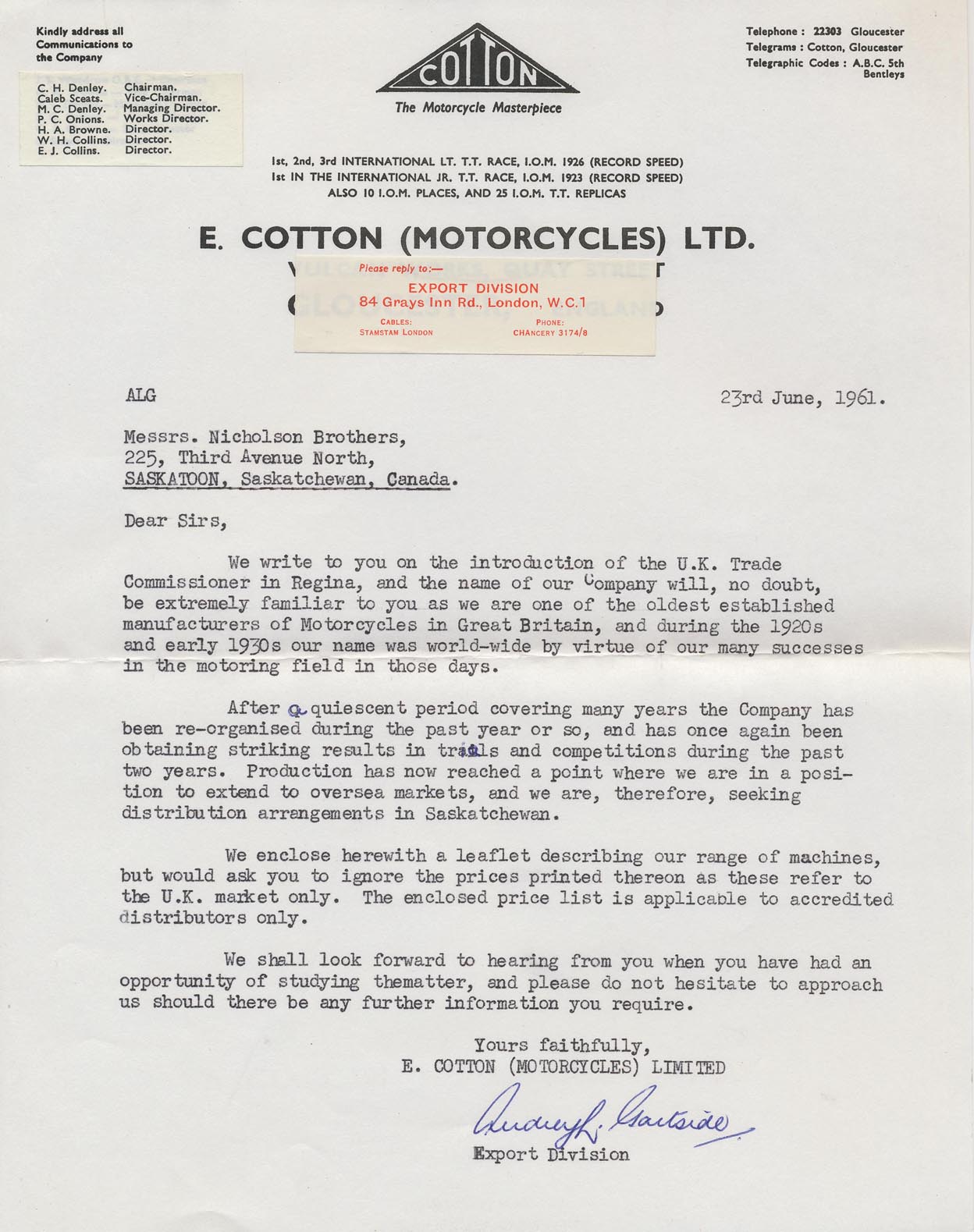After seeing the recent Throttle Yard posting for an octet of Cottons for sale, I thought this might prove of interest. I wrote this short Cotton history as my Winter 2009 Pulp Non Fiction column in theAntique Motorcycle Club of America’s magazine — the Antique Motorcycle.
Say the word ‘cotton’ and most people would think of the material used to produce Levi's jeans or Hanes T-shirts.
But say the word ‘cotton’ around a few motorcycle cognoscenti and another image entirely might emerge – that of a storied British marque famous for winning Isle of Man TT races and other competitions.

In 1913 Frank Willoughby Cotton of Gloucester, England designed a unique triangulated motorcycle frame and patented the idea in 1914. Cotton’s frame was stronger than the spindly ‘bicycle’ diamond-type chassis that was in vogue at the time. Cotton enlisted the help of Levis — another British motorcycle maker — to build two samples of his new frame but the First World War intervened and hampered his plans to bring a complete machine to market. It wasn’t until 1919 that the Cotton Motorcycle Company came into existence, and the first Cotton appeared in 1920.
Purported to have an extremely low center of gravity Cotton motorcycles became a popular mount for racing, and this did not escape F.W. Cotton’s attention. He saddled Stanley Woods on a 350cc Blackburne-powered Cotton in the 1922 Isle of Man Junior TT, and Woods managed a respectable fifth-place finish. (During his 1922 outing on the 350cc Cotton, just about everything that could go wrong, did. He botched the start, having to stop to retrieve some fallen spark plugs. The machine caught fire in the pits. Not long after putting out the flames and back on the circuit, Woods had to stop and wrestle with the valves thanks to a broken push rod.)
In 1923 Woods won the TT aboard a Cotton, and a bit of a sales boom occurred in 1924 after the factory swept the first three spots in the Junior TT. Cotton used a variety of engines in his triangulated frame, including side valve and overhead valve Blackburne, OHV JAP and Villiers two stroke units.
In this 1938 brochure Cotton offered ‘14 Superlative Models’, and advertised that ‘Cotton Stability Makes Speed Safe’. Of the 14 models available there were three 350cc machines, the Model 9/38, 350/38 and 9/Special. These all had OHV JAP powerplants, but the Special was fitted with a high camshaft JAP engine. There were three 500cc motorcycles, the 500/38, 5/Special and 25/Special. A 500cc JAP five-horsepower single was specified for each; the 5/Special was an S-Sports engine while the 25/Special employed a high camshaft unit. The largest Cotton was the Model 600/38 with a 600cc OHV JAP.
In the 250cc range there were three motorcycles, including Model 6/B, 250/38 and 30/Special. The 6/B ran a 250cc OHV Blackburne engine, while the last two used 250cc OHV JAP engines.
All of the machines listed above featured “The famous Cotton Patent Triangulated (frame) – by common consent the Masterpiece of modern design – giving perfect riding position with magnificent stability and controllability. Originated the phrase ‘Speed with Utter Safety.’ Front and rear wheel stands fitted.” Forks were specially-constructed Cotton-Druid girders.
Further specifications include a Burman three-speed gearbox, with a four-speed Burman listed as an option. Carburetion is via Amal TT or Bowden, and ‘silencing’ is carried out “By imposing large bore chromium plated exhaust pipe, leading to a sports cylindrical silencer. These modern upswept pipes remain immaculate, and improve appearance.”

So far, we’ve covered 10 Cotton models. The remaining four are the Model 1/V, fitted with a 150cc Villiers two stroke, Model 1/B with a 150cc OHV Blackburne, Model 2/JC and 2/J, both powered by a 250cc sidevalve JAP – for a total of 14 motorcycles.
Cotton suspended the manufacture of motorcycles during the World War II period, with the factory turned over to the manufacture of war goods. Post-war, Cotton did not immediately return to the production of motorcycles.
By 1953 Cotton’s triangulated frame was of course obsolete, given the rear swinging-arm suspension systems that were coming into widespread use. F.W. Cotton himself retired in 1953, and the concern was branded E. Cotton (Motorcycles) Ltd. Several models were produced, with Cotton making frames only and most every other component bought in.

A letter dated 23 June 1961, addressed to the Nicholson Bros. of Nicholson Bros. Motorcycles in Saskatoon, Saskatchewan enquired after overseas dealers.
“After a quiescent period covering many years the Company has been re-organized during the past year or so, and has once again been obtaining striking results in trials and competitions during the past two years. Production has now reached a point where we are in a position to extend to overseas markets, and we are, therefore, seeking distribution arrangements in Saskatchewan.”

Nicholsons did not take on Cotton, but for 1961 the range included eight models such as the Vulcan 4-speed 197cc Road or Sports and the 250cc Scrambler and the Continental Duplex Frame 250cc. Two-stroke Villiers engines powered all models.
Cotton soldiered on in the late 1960s after Villiers quit supplying engines, building primarily competition machines around Italian-made Minarelli engines and even a 250cc Rotax powerplant.
Cotton lasted until 1980, much longer than many other British ‘cycle builders.
Say the word ‘cotton’ and most people would think of the material used to produce Levi's jeans or Hanes T-shirts.
But say the word ‘cotton’ around a few motorcycle cognoscenti and another image entirely might emerge – that of a storied British marque famous for winning Isle of Man TT races and other competitions.

In 1913 Frank Willoughby Cotton of Gloucester, England designed a unique triangulated motorcycle frame and patented the idea in 1914. Cotton’s frame was stronger than the spindly ‘bicycle’ diamond-type chassis that was in vogue at the time. Cotton enlisted the help of Levis — another British motorcycle maker — to build two samples of his new frame but the First World War intervened and hampered his plans to bring a complete machine to market. It wasn’t until 1919 that the Cotton Motorcycle Company came into existence, and the first Cotton appeared in 1920.
Purported to have an extremely low center of gravity Cotton motorcycles became a popular mount for racing, and this did not escape F.W. Cotton’s attention. He saddled Stanley Woods on a 350cc Blackburne-powered Cotton in the 1922 Isle of Man Junior TT, and Woods managed a respectable fifth-place finish. (During his 1922 outing on the 350cc Cotton, just about everything that could go wrong, did. He botched the start, having to stop to retrieve some fallen spark plugs. The machine caught fire in the pits. Not long after putting out the flames and back on the circuit, Woods had to stop and wrestle with the valves thanks to a broken push rod.)
In 1923 Woods won the TT aboard a Cotton, and a bit of a sales boom occurred in 1924 after the factory swept the first three spots in the Junior TT. Cotton used a variety of engines in his triangulated frame, including side valve and overhead valve Blackburne, OHV JAP and Villiers two stroke units.
In this 1938 brochure Cotton offered ‘14 Superlative Models’, and advertised that ‘Cotton Stability Makes Speed Safe’. Of the 14 models available there were three 350cc machines, the Model 9/38, 350/38 and 9/Special. These all had OHV JAP powerplants, but the Special was fitted with a high camshaft JAP engine. There were three 500cc motorcycles, the 500/38, 5/Special and 25/Special. A 500cc JAP five-horsepower single was specified for each; the 5/Special was an S-Sports engine while the 25/Special employed a high camshaft unit. The largest Cotton was the Model 600/38 with a 600cc OHV JAP.
In the 250cc range there were three motorcycles, including Model 6/B, 250/38 and 30/Special. The 6/B ran a 250cc OHV Blackburne engine, while the last two used 250cc OHV JAP engines.
All of the machines listed above featured “The famous Cotton Patent Triangulated (frame) – by common consent the Masterpiece of modern design – giving perfect riding position with magnificent stability and controllability. Originated the phrase ‘Speed with Utter Safety.’ Front and rear wheel stands fitted.” Forks were specially-constructed Cotton-Druid girders.
Further specifications include a Burman three-speed gearbox, with a four-speed Burman listed as an option. Carburetion is via Amal TT or Bowden, and ‘silencing’ is carried out “By imposing large bore chromium plated exhaust pipe, leading to a sports cylindrical silencer. These modern upswept pipes remain immaculate, and improve appearance.”

So far, we’ve covered 10 Cotton models. The remaining four are the Model 1/V, fitted with a 150cc Villiers two stroke, Model 1/B with a 150cc OHV Blackburne, Model 2/JC and 2/J, both powered by a 250cc sidevalve JAP – for a total of 14 motorcycles.
Cotton suspended the manufacture of motorcycles during the World War II period, with the factory turned over to the manufacture of war goods. Post-war, Cotton did not immediately return to the production of motorcycles.
By 1953 Cotton’s triangulated frame was of course obsolete, given the rear swinging-arm suspension systems that were coming into widespread use. F.W. Cotton himself retired in 1953, and the concern was branded E. Cotton (Motorcycles) Ltd. Several models were produced, with Cotton making frames only and most every other component bought in.

A letter dated 23 June 1961, addressed to the Nicholson Bros. of Nicholson Bros. Motorcycles in Saskatoon, Saskatchewan enquired after overseas dealers.
“After a quiescent period covering many years the Company has been re-organized during the past year or so, and has once again been obtaining striking results in trials and competitions during the past two years. Production has now reached a point where we are in a position to extend to overseas markets, and we are, therefore, seeking distribution arrangements in Saskatchewan.”

Nicholsons did not take on Cotton, but for 1961 the range included eight models such as the Vulcan 4-speed 197cc Road or Sports and the 250cc Scrambler and the Continental Duplex Frame 250cc. Two-stroke Villiers engines powered all models.
Cotton soldiered on in the late 1960s after Villiers quit supplying engines, building primarily competition machines around Italian-made Minarelli engines and even a 250cc Rotax powerplant.
Cotton lasted until 1980, much longer than many other British ‘cycle builders.




![1909 Torpedo V4 Replica [ VIDEO ] 1909 Torpedo V4 Replica [ VIDEO ]](https://blogger.googleusercontent.com/img/b/R29vZ2xl/AVvXsEgfdPjZpZUJV1SztVbrzWsoYN-hXirKx2EKwbvj6yV1F9MCOJBIqDQk5X7NwONJDrmFV6djQ3HeogaYlmcSUNXJcHmh060uo4D8ec3ErqhnQX488lc3LDXNS3zpIboYgH2CRaX1PySc34M/w75-h75-p-k-no-nu/torpedo-v4-leftside.jpg)



